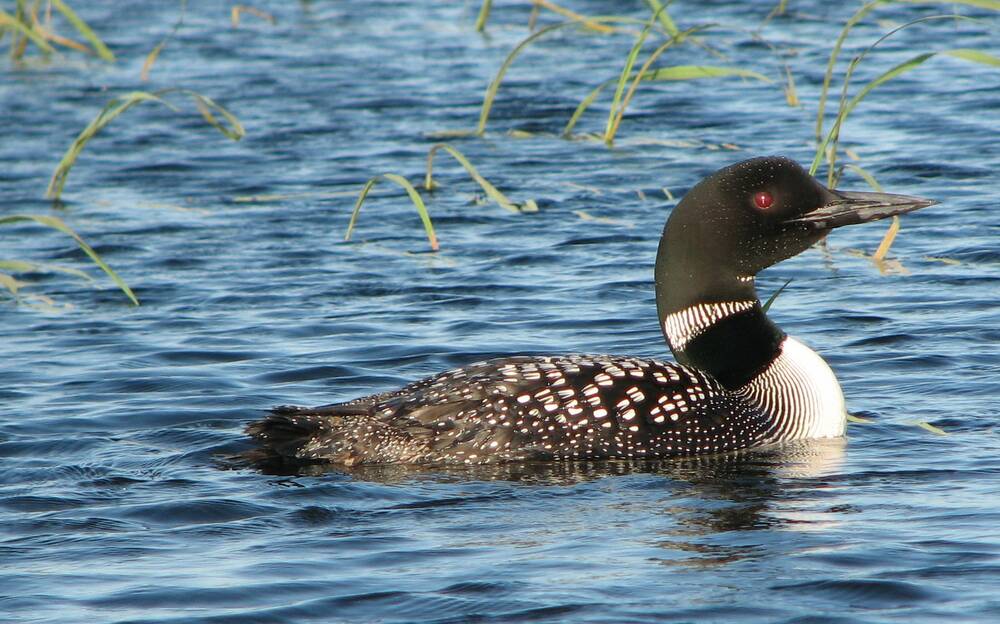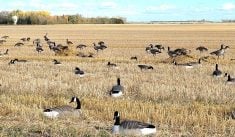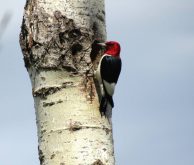For such a majestic bird, the name of the common loon seems almost like an insult.
There’s nothing ordinary about these birds. If it were up to me, we’d follow Europe’s example. There, the common loon is called the great northern diver.
Why it matters: The cry of a loon echoing over a quiet lake is a cherished summer memory for many rural Manitobans.
Read Also

Duguid named to MFGA Wall of Fame
Interlake farmer Mike Duguid has become the latest to join the Manitoba Forage and Grassland Association’s Wall of Fame. The…
The species is common in that they are the most abundant and widespread of the world’s five loon species. Most loons you see in Manitoba will be common loons, unless you’re in some of our most northern regions, where other species like Arctic, Pacific and red-throated loons can be found.
Loons are mainly found in North America. A few nest in the lower 48 U.S. states, but most breed in forested and southern arctic areas of Canada and Alaska. Southern Baffin Island, Greenland and Iceland are also breeding areas. Atlantic and Pacific seacoasts provide wintering areas.
The name of the family seems to originate with an old English word: lumme, meaning lummox or awkward person.
Loons on land do look awkward, with their legs so far back on their bodies. That’s only on land, though. In the water, that shape makes them effective underwater predators.
Weighing four to six kilograms, loons are dense, compact and sit low in the water. They’re heavier than most geese, despite being smaller. Because of that, takeoffs from the water are a slow, lumbering process. They need at least 100 metres of open water for takeoff, plus extra distance to get above treetops.
Once in the air, they’re fast fliers.
They can’t extend their legs forward to land as ducks and geese do (another effect of their far-back legs). Instead, they break their speed with a long belly-slide on the water surface. It looks much more graceful than it sounds.
The common loon feeds mainly on small fish, but also eats crayfish, snails, mollusks and large insects. They routinely dive as deep as 30 metres, but they can go twice that depth in search of food.

Sights and sounds
Loons are basically a study in black and white. The black head shows green or dark blue iridescence when the light hits it right. The rest of the body is basic black with patterns of white streaks and spots that, even at close range, seem to be painted on with an artist’s precision.
Up close, a blood-red eye stands out. The colour apparently enhances their vision under water.
Then there are the calls. Most in rural Manitoba can recognize a loon call when they hear one.
There are four distinct loon sounds: a tremolo, often termed their laughing or lunatic call; a yodel, which is a complicated call used mainly for territorial defence; a mournful wail, suggestive of a wolf, which helps mates to keep in touch over long distances; and a quiet hoot for close-range communication within a group.
Nesting season
Common loons seek out lakes and rivers in forested areas with clear water. In this province, they are just about everywhere except the prairie pothole region, though even there, loons are found in forested provincial parks like Turtle Mountain and Spruce Woods.

Loons need lots of elbow room and an abundance of small fish. Small lakes will only have a single pair, while larger lakes with many bays and islands can hold more. Small ponds are avoided due to takeoff requirements.
Loons show up locally in late April and begin to nest in early May.
They are known for their monogamy, although that is not entirely accurate. Pairs do tend to stick together, but if one bird dies, another mate is sought. Breakups can also occur.
A pair that nests and rears young will split up in the fall and winter, but they will rejoin on their breeding territory the next spring and, if they defend their patch of water, will nest there again. A rival male might also arrive, however, and challenge the incumbent.
If the usurper wins a contest of spirited displays, calls and fights, it takes over the territory and the female. Mate-switching can also occur if a new female beats out the territorial female.
Territorial challenges help explain why loons are so vocal. Defending territory comes down to the need for good fishing water and nest sites. It has been estimated that a season of nesting, feeding and rearing young requires over 400 kilograms of fish.
Nesting and rearing
Because loons have to push themselves along the ground to make headway when land-bound, they only come to land to nest, and nests are usually only a body-length from the water. A platform of vegetation is built to add elevation and create a nest bowl.
One or two eggs are laid and incubated for about 27 days. It’s a short-term residency; the family is on the move not long after the young hatch and dry out.
I have come across two loon nests over the years. One was on a rocky island in a large river system that, although protected from land-based predators, ultimately lost out to rain and rising water levels. The other was on a mat of floating bog in a marshy backwater off a larger lake. It was safe from rising water but unfortunately was hit by a predator.

While the adults are unattractive targets, foxes, skunks, raccoons, gulls and crows can attack untended eggs.
Despite my less than stellar examples, loon nest success is estimated around 40 per cent, which is on the high side for ground-nesting birds.
Hatched young also have fair chances of survival. Their main threats are snapping turtles, large pike, eagles or even other harassing loons.
Young chicks are often seen riding a parent’s back while the other parent brings a constant supply of minnows and other carnivorous delights. By the time they can fly, young birds have begun to master the art of feeding themselves.
Once grown, they have few predators in Manitoba, except for the occasional eagle. On their seacoast wintering grounds, however, there are reports of orcas or sharks taking some birds. Annual survival rates for adults are estimated at 90 percent, which explains why loons often live for two decades or more.
Loons and people
Our family cottage on the Winnipeg River is in the heart of loon country. I listen for loon calls in the quiet of dawn and dusk.
Decades ago, when I spent some time alone in a wilderness area, their calls seemed to magnify my sense of loneliness. Closer to home, this is the awe-inspiring sound of our wild areas, at least to me.
These days, as I quietly glide along a shoreline during a morning of fishing, I am not surprised if a loon pops up close to the boat. I may see the flash of a hapless minnow before it goes down the gullet.

Perhaps they are checking me out. I’ve had many encounters when loons are only a few metres away and they gave me time to dig out my camera. Like photographers and artists before me, I am drawn to their spectacular plumage and the intense, ever-watchful red eye.
The visually and vocally striking bird figures prominently in traditional Indigenous stories. Loons are central to an Ojibwe creation story and figure prominently in a Mi’kmaw saga as a messenger.
Modern surveys show stable common loon populations over the last 25 years, helped by the fact that most of their breeding range is in the relatively undisturbed north. The continental population is estimated at a little over 600,000 birds.
That doesn’t mean there are no conservation concerns.
Loons are susceptible to mercury contamination, made worse when lakes and rivers are flooded for hydro-electric power reservoirs or in regions affected by acid rain. In both scenarios, additional mercury is released into the water and, through an ecosystem process called “bioaccumulation” in which toxins flow from prey to predator, top-level predators end up with the highest concentrations of toxins.
Because loons live so long, the effect is even more pronounced. Studies have found that higher body mercury levels lead to lower reproductive success, poorer body condition and changes in important behaviours, like the frequency of feeding.
Loons are also susceptible to lead poisoning. One problematic source is believed to be small fishing weights that birds can pick up when they feed, especially in more settled areas.
Loons have adapted to a certain level of human intrusion in recreational areas. They can tolerate modest levels of shoreline development, admiring paddlers and the thoughtless antics of a few motorboat drivers.
But some areas now have too much shoreline development and are too overrun with boats, so the loons must move on.
If we want our future to include an abundance of loons, we need to look at some of the bigger environmental impacts on our continent as well as the intensity with which we intrude and recreate in their habitats. It’s hard to imagine our wild areas without the cry of loons.
















